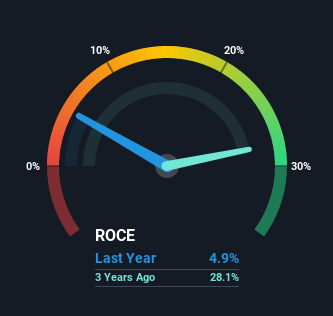- India
- /
- Entertainment
- /
- NSEI:SHEMAROO
Be Wary Of Shemaroo Entertainment (NSE:SHEMAROO) And Its Returns On Capital
Did you know there are some financial metrics that can provide clues of a potential multi-bagger? Ideally, a business will show two trends; firstly a growing return on capital employed (ROCE) and secondly, an increasing amount of capital employed. Basically this means that a company has profitable initiatives that it can continue to reinvest in, which is a trait of a compounding machine. In light of that, when we looked at Shemaroo Entertainment (NSE:SHEMAROO) and its ROCE trend, we weren't exactly thrilled.
What is Return On Capital Employed (ROCE)?
Just to clarify if you're unsure, ROCE is a metric for evaluating how much pre-tax income (in percentage terms) a company earns on the capital invested in its business. The formula for this calculation on Shemaroo Entertainment is:
Return on Capital Employed = Earnings Before Interest and Tax (EBIT) ÷ (Total Assets - Current Liabilities)
0.049 = ₹291m ÷ (₹8.8b - ₹2.9b) (Based on the trailing twelve months to September 2021).
Therefore, Shemaroo Entertainment has an ROCE of 4.9%. On its own that's a low return, but compared to the average of 3.0% generated by the Entertainment industry, it's much better.
See our latest analysis for Shemaroo Entertainment

Historical performance is a great place to start when researching a stock so above you can see the gauge for Shemaroo Entertainment's ROCE against it's prior returns. If you want to delve into the historical earnings, revenue and cash flow of Shemaroo Entertainment, check out these free graphs here.
What Can We Tell From Shemaroo Entertainment's ROCE Trend?
When we looked at the ROCE trend at Shemaroo Entertainment, we didn't gain much confidence. Over the last five years, returns on capital have decreased to 4.9% from 29% five years ago. On the other hand, the company has been employing more capital without a corresponding improvement in sales in the last year, which could suggest these investments are longer term plays. It may take some time before the company starts to see any change in earnings from these investments.
What We Can Learn From Shemaroo Entertainment's ROCE
In summary, Shemaroo Entertainment is reinvesting funds back into the business for growth but unfortunately it looks like sales haven't increased much just yet. And investors appear hesitant that the trends will pick up because the stock has fallen 68% in the last five years. Therefore based on the analysis done in this article, we don't think Shemaroo Entertainment has the makings of a multi-bagger.
On a final note, we found 4 warning signs for Shemaroo Entertainment (2 are potentially serious) you should be aware of.
While Shemaroo Entertainment may not currently earn the highest returns, we've compiled a list of companies that currently earn more than 25% return on equity. Check out this free list here.
New: Manage All Your Stock Portfolios in One Place
We've created the ultimate portfolio companion for stock investors, and it's free.
• Connect an unlimited number of Portfolios and see your total in one currency
• Be alerted to new Warning Signs or Risks via email or mobile
• Track the Fair Value of your stocks
Have feedback on this article? Concerned about the content? Get in touch with us directly. Alternatively, email editorial-team (at) simplywallst.com.
This article by Simply Wall St is general in nature. We provide commentary based on historical data and analyst forecasts only using an unbiased methodology and our articles are not intended to be financial advice. It does not constitute a recommendation to buy or sell any stock, and does not take account of your objectives, or your financial situation. We aim to bring you long-term focused analysis driven by fundamental data. Note that our analysis may not factor in the latest price-sensitive company announcements or qualitative material. Simply Wall St has no position in any stocks mentioned.
About NSEI:SHEMAROO
Shemaroo Entertainment
Engages in the distribution of content for broadcasting of satellite channels, physical formats and digital technologies in India.
Good value with mediocre balance sheet.
Similar Companies
Market Insights
Community Narratives




